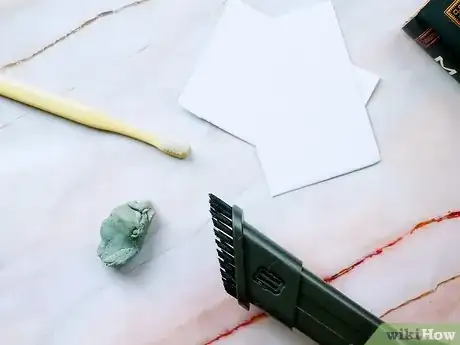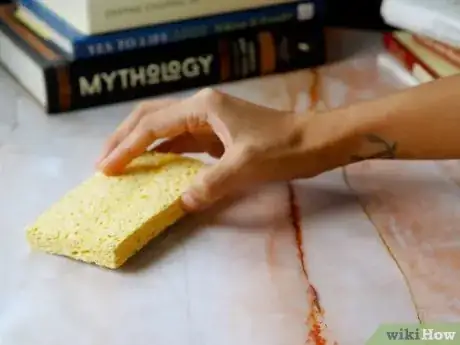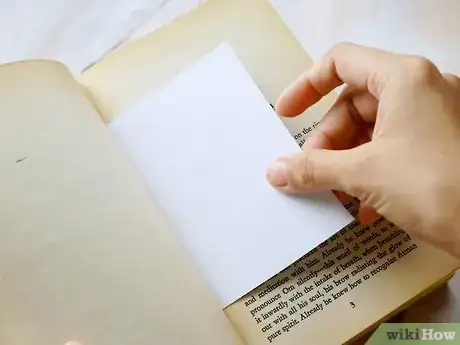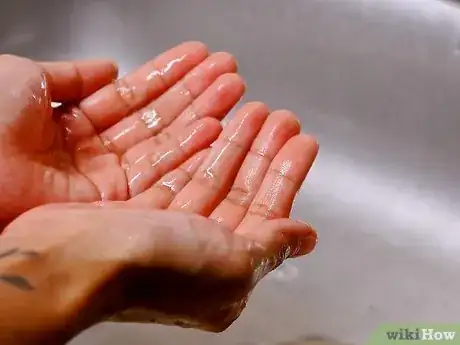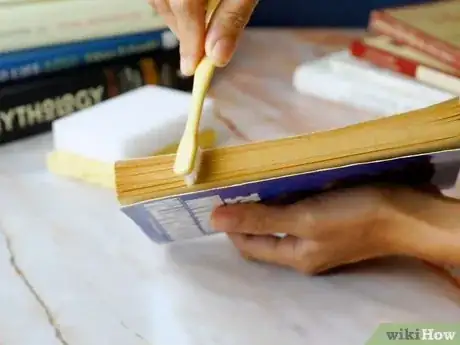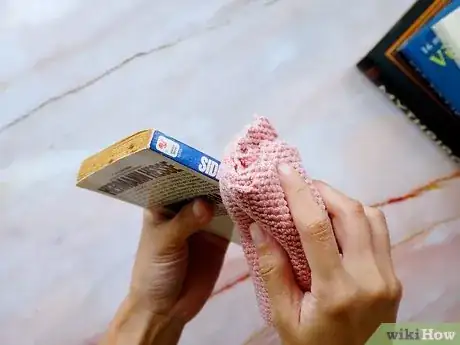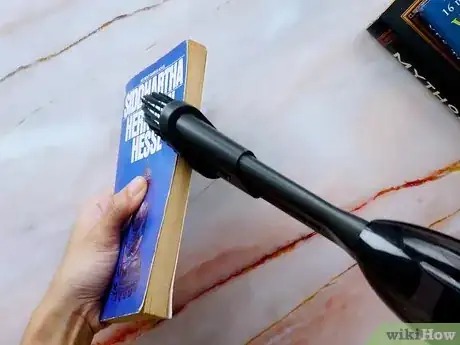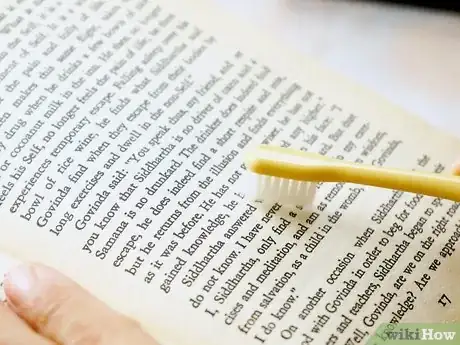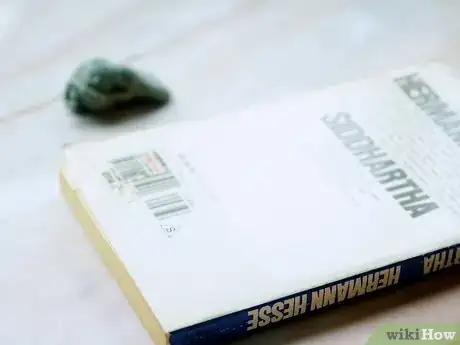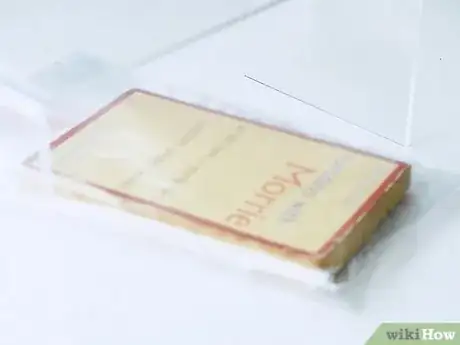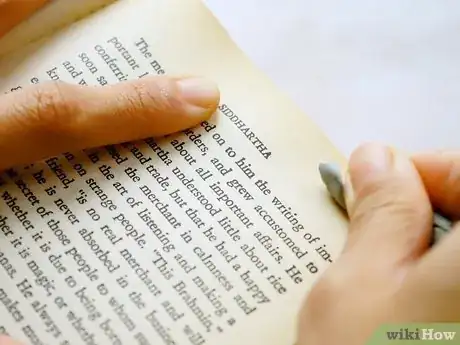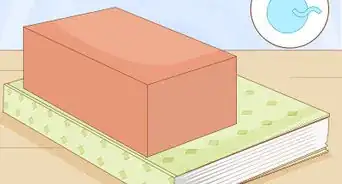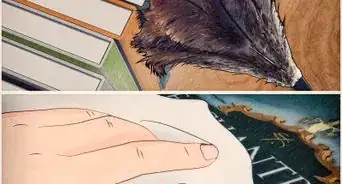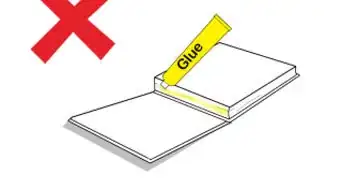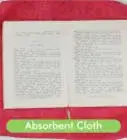This article was co-authored by wikiHow Staff. Our trained team of editors and researchers validate articles for accuracy and comprehensiveness. wikiHow's Content Management Team carefully monitors the work from our editorial staff to ensure that each article is backed by trusted research and meets our high quality standards.
The wikiHow Video Team also followed the article's instructions and verified that they work.
This article has been viewed 328,948 times.
Learn more...
With frequent usage and toting about, your favorite books may become dirty, dusty, or even stained. While it’s best to take antique or overly fragile books to conservationists for cleaning and preservation, you can clean newer books that are in relatively good condition by yourself at home. You’ll need to collect a few crucial supplies and be prepared to use a gentle hand to properly clean and care for your treasured tomes.
Steps
Organizing Your Cleaning Supplies and Space
-
1Gather a variety of cleaning implements. Different parts of the book will require their own cleaning methods. You’ll want multiple tools on hand to address any potential problems your book may have.[1]
- An artgum eraser is the perfect object for removing small pencil marks, smudges, and medium-sized blemishes on the pages.
- A soft cloth such as cut-up white t-shirt works well for gently cleaning surface dirt. You can also try an electrostatic cloth for an option that both lifts and holds dirt.
- You’ll need a small, soft brush, such as a toothbrush, to clean bindings and page edges.
- If your book is extremely dirty or dusty, you might need to vacuum the surface. You’ll need a vacuum with a low-suction setting and a soft-brush attachment.[2]
- A document cleaning pad, which is a sieved cloth filled with eraser dust, will help remove a layering of dust from the pages, as well as smudges from matte dust jackets.
-
2Assemble the necessary cleaning solutions. You’ll need a few different supplies to deal with your book’s various components and unique trouble spots. Be sure to have access to petroleum jelly, a book cleaner putty, absorbent paper towels, and baking soda.[3]Advertisement
-
3Choose an appropriate spot for cleaning. Once you’ve collected all your supplies, set them up in a well-lit, comfortable work area. You’ll want plenty of space to spread out in an area you don’t mind getting a bit dirty.
-
4Place the book in a padded wedge. Your book will need to be supported as you clean it. Use pads that keep the book partially but not completely open as you turn the pages. This will prevent the binding from breaking.[4]
- You can use clean, rolled-up towels to create a homemade wedge for the book, or you can purchase a set of foam wedges.
-
5Record what needs to be cleaned. Check the book over and make a list of all the areas that need to be cleaned. Place small pieces of paper in between the pages that you’ll need to clean in order to bookmark them.
-
6Wash your hands. You don’t want to add to the grime or oils that may be plaguing your book by touching it with dirty hands. Even if you think your hands are clean, you have natural oils on your skin that it’s crucial to remove before starting the cleaning process.[5]
Performing a General Clean
-
1Start with the outside edges of the book. Keep the book firmly closed and use your soft cloth or toothbrush to gently brush the edges of the pages. Start at the top, or head, and wipe away from the spine. Continue with the fore-edge, or the edge opposite the spine, and the tail, or bottom of the book.[6]
- Use extreme caution with any tears or damaged edges. Use the soft brush to very gently address these spots.
-
2Brush the spine and outer boards of the book. Wipe the spine with your cloth or brush, moving in one direction only. In order to protect the boards, mentally divide the front and back cover into halves and wipe from that center rather than from one end to the other.[7]
- If the spine has raised horizontal bands, wipe across rather than up and over the bumps.
- Be careful of any damaged edges, leather corners, or decoration. Avoid snagging the brush or cloth on these elements.
-
3Use your vacuum for heavy dust or mold on the outside of the book. Ensure that your attachment is an extremely soft brush, and place your vacuum on the lowest possible setting. Gently and carefully vacuum up the dirt, moving in only one direction. Start with the head, move to the fore-edge, then the tail, and finally finish with the spine and outer boards.
- For damaged books, place some cheesecloth or a nylon stocking over the end of the vacuum. Vacuum up the dirt on the medium setting without touching the book by hovering just above the surface of the book.
-
4Clean the dust jacket. Many books now come with dust jackets. These paper coverings are generally glossy or matte in finish. While they’re attractive, they often get dusty and may also tear. Use your soft cloth to gently brush any dust or dirt off the jacket.
-
5Clean the pages. Set the book in your wedges, carefully open the book, and turn the pages. Use your soft cloth or toothbrush to wipe the page from the center of book outwards, removing dust as you go.[8]
-
6Address mustiness. If your book has a musty smell that you can’t isolate to individual pages, place the book in a plastic, resealable bag with a sprinkling of baking soda or unscented cat litter. Leave it in the bag for a minimum of 12 hours and up to two weeks.[9]
Getting Rid of Marks and Smudges
-
1Use your artgum eraser to remove smudges and small marks from the pages. Always erase in one direction only. Use your soft cloth to brush away eraser crumbs when finished.
- While the eraser should remove most pencil and some pen marks, it likely won’t take care of dark stains. Dark ink or food stains may be impossible to remove from your book without damaging the pages.
-
2Address insect infestations by freezing the book. If any pages show signs of insects, brush off the insect or egg debris, place the book in a fully sealed plastic freezer bag, and then put it in the freezer for 24 hours to kill any remaining infestation. Thaw the book slowly by first putting it in the refrigerator for 8 hours.
-
3Employ a book cleaner putty for stubborn smudges. Book cleaner putties have the consistency of Play-Doh and can be purchased in small tubs. Take a small amount and roll the putty in your hands to warm it up, then gently rub the warmed ball over either the pages of your book or a cloth cover. Move in one direction only.[10]
-
4Remove oil stains with absorbent paper towels. Oil and grease stains may be difficult to completely erase, especially if they’ve had time to fully set in. Try pressing paper towels in between the pages of the book, close the book, and weigh it down with a book weight. Allow the towel to absorb the stain for 2-3 days, then check on its progress. Keep repeating as necessary.[11]
- If your stain is from food, remove this first. Freeze the book for 24 hours and then gently scrape off the food with a plastic knife.[12]
- To make a homemade book weight, fill a cloth bag with dry beans or rice. Ensure the bag is sealed before use.
-
5Clean smudges off your dust jacket. Depending on the material of your dust jacket, you’ll need to use a different material for cleaning. These materials will clean your jacket without damaging it.
- For a matte dust jacket, which will not be shiny in appearance, gently address smudges by shaking your document cleaning pad to release the eraser dust. Then rub the dust onto the dust jacket, and gently brush it off when finished.[13]
- For a glossy dust jacket, rub a bit of petroleum jelly onto any smudges with a soft cloth. Use a different cloth to wipe off the jelly and fully remove the smudge.[14]
Community Q&A
-
QuestionHow can I remove darker stains, such as from chocolate, juice, or ink?
 Community AnswerSadly, some stains are too stubborn to remove without doing damage to your book. If the methods discussed in the article, especially using an art gum eraser, didn't work on your stain, you may need to accept that it's permanent. Do not try to use a cleaning solution containing bleach on the stains, as you'll damage the page.
Community AnswerSadly, some stains are too stubborn to remove without doing damage to your book. If the methods discussed in the article, especially using an art gum eraser, didn't work on your stain, you may need to accept that it's permanent. Do not try to use a cleaning solution containing bleach on the stains, as you'll damage the page. -
QuestionIs there a way to take greasy fingerprints off the pages of classic children's books?
 Community AnswerGet a damp tissue and a dry tissue. Dab the marks with the wet tissue, then dry them with the dry tissue. Repeat these steps until the fingerprints have been removed. You can dry the pages with a hairdryer at the end if you need to.
Community AnswerGet a damp tissue and a dry tissue. Dab the marks with the wet tissue, then dry them with the dry tissue. Repeat these steps until the fingerprints have been removed. You can dry the pages with a hairdryer at the end if you need to. -
QuestionHow do I clean the edges of the pages?
 Community AnswerClose the book and clamp it tightly shut. Then take a small, clean paint brush and stroke the dirty area(s) in one direction, going away from the spine.
Community AnswerClose the book and clamp it tightly shut. Then take a small, clean paint brush and stroke the dirty area(s) in one direction, going away from the spine.
Warnings
- Do not use bleach or household cleaners to attempt to remove stains from your book. These solutions will almost certainly damage the book.⧼thumbs_response⧽
- Take extra care with leather- and vellum- bound books, as well as older books. In many cases, self-cleaning is not the best option for these items. Take them to an antiquarian bookseller or collector for advice tailored to the specific book's needs.⧼thumbs_response⧽
Things You'll Need
- Soft cloth rag
- Soft toothbrush
- Vacuum with soft-brush attachment and low and medium suction capability
- Cheesecloth or nylon stocking
- Artgum eraser
- Document cleaning pad
- Book cleaner putty
- Petroleum jelly
- Rolled-up cloths or foam wedges
- Paper towels
- Book weight
- Baking soda
- Resealable plastic bags
References
- ↑ http://www.biblio.com/book-collecting/care-preservation/cleaning-books/
- ↑ https://www.nedcc.org/free-resources/preservation-leaflets/4.-storage-and-handling/4.3-cleaning-books-and-shelves
- ↑ http://www.shopbrodart.com/book-care/
- ↑ http://www.vam.ac.uk/content/articles/c/caring-for-your-books-and-papers/
- ↑ http://www.shopbrodart.com/book-care/
- ↑ https://www.bl.uk/aboutus/stratpolprog/collectioncare/publications/booklets/cleaning_books_and_documents.pdf
- ↑ https://www.bl.uk/aboutus/stratpolprog/collectioncare/publications/booklets/cleaning_books_and_documents.pdf
- ↑ https://www.bl.uk/aboutus/stratpolprog/collectioncare/publications/booklets/cleaning_books_and_documents.pdf
- ↑ http://www.shopbrodart.com/book-care/
- ↑ http://bookriot.com/2012/12/14/the-beginners-guide-to-cleaning-your-books/
- ↑ http://www.shopbrodart.com/book-care/
- ↑ http://bookriot.com/2012/12/14/the-beginners-guide-to-cleaning-your-books/
- ↑ http://bookriot.com/2012/12/14/the-beginners-guide-to-cleaning-your-books/
- ↑ http://www.shopbrodart.com/book-care/
About This Article
To clean a book, prop it up on a padded wedge on a flat, clean surface. Mark any spots in the book that need to be cleaned with bookmarks or pieces of paper. Wash your hands with soap and water and dry them thoroughly. Keep the book closed and wipe down the outside edges of the pages with a soft cloth or toothbrush. Then, brush or wipe the spine and outer boards, moving in a single direction. If there’s any loose dust or dirt on the outside of the book, vacuum it with a soft brush attachment. Wipe down the dust jacket with your cloth or brush, then brush each page clean, moving from the center outward. If there are smudges on any pages, gently rub them away with a gum eraser or a piece of cleaning putty. For tips on removing musty smells from books, read on!
